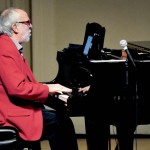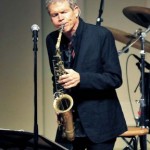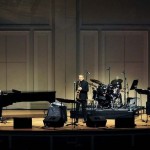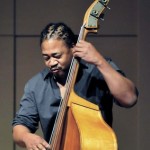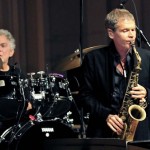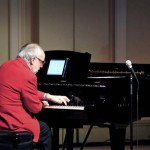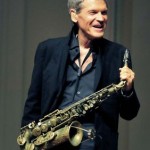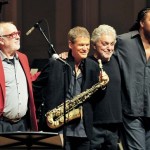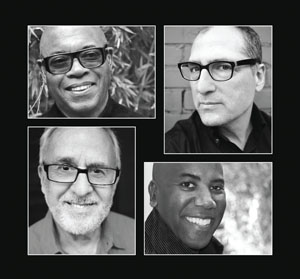Bob James & David Sanborn Speak Volumes through Music as St. Cecilia Music Center’s 2013 Great Artists
by Veritas on Oct.26, 2013, under Press &Reviews
GRAND RAPIDS, MI – What sets jazz apart from other forms of American music is it’s a conversation that happens in real time.
Saxophonist David Sanborn and pianist Bob James had a lot to say at St. Cecilia Music Center on Thursday.
Sanborn and James were in Grand Rapids as St. Cecilia’s 2013 Great Artists, an annual gala event that’s brought the likes of Itzhak Perlman, James, Galway, Victor Borge, Denyce Graves and Tony Bennett to Royce Auditorium.
With drummer Steve Gadd and bassist James Genus, the quartet opened St. Cecilia Music Center’s 130th season to an enthusiastic, sold-out audience.
They did not disappoint with an evening of 10 tunes played during an hour and 45 minutes that stretched across a quarter century of contemporary jazz.
With James’ solo opening chords on “Montezuma,” the group announced its arrival with authority.
Sanborn, who played at Woodstock with Butterfield Blues Band and who has recorded eight gold albums and one platinum album, and James, a member of Fourplay with some 58 recordings to his credit, need little introduction. Only a little background.
Some 25 years ago, they went into the studio and made an album that was a one-off. “Double Vision” turned out to be big hit and a Grammy Award winner. But only after it was too late to organize a tour.
Having performed live together just once, several years ago, Sanborn and James returned to the studio last December to record a new album, “Quartette Humaine.”
Without being told, you would not guess they’ve hardly ever been together in concert.
Their musical repartee is the Algonquin Roundtable in progress, only it involves musical instruments.
The ghost of Dave Brubeck loomed large over Thursday’s proceedings. Tunes on “Quartette Humaine” pay obvious homage to the Dave Brubeck Quartet.
But Paul Desmond’s dry-as-a-martini tone and Sanborn’s sultry, seductive, late-night moan have little in common. Desmond’s solos woo a woman playfully. Sanborn’s approach, when playing songs such as “Sofia,” involves handcuffs. It’s a good thing Sofia is his wife.
Sanborn’s solo on “More than Friends” from “Double Vision” mostly stayed in his altissimo register. But while other saxophonists pop off a few squeals, carefully placed, Sanborn plays entire melodies that would be a stretch for a soprano saxophonist to reach.
James, whose best-known tune is “Angela,” the theme from the TV show, “Taxi,” is a chameleon on piano. With tunes such as “You’d Better Not Go to College,” he’s happy to channel Brubeck’s melodic, contrapuntal accompaniment and then play carefully constructed solos with an animated, but carefree contentment.
James’ “Follow Me,” which goes well beyond Brubeck’s experiments with three, five or seven beats per bar, packs a good 17 or so beats into the bar for a playful, intense experience. Even Gadd on drums had to keep a close eye on the printed page.
Songs such as “My Old Flame” rolled with gospel fervor.
The sound, though loud, was managed rather well in Royce Auditorium.
James Genus plays double bass with an electric bass player’s technique, using several fingers to pluck his strings, sometimes doubling up for added oomph. He plays remarkably fast, though sometimes he seems more concerned with how many notes he plays than with what he’s saying with them.
Steve Gadd, one of the great contemporary jazz drummers, who’s toured with Grover Washington Jr., Al DiMeola, Tom Scott and more, plays with an uncommon balance of power and melodic grace.
“Maputo,” the breakaway big hit from “Double Vision,” was a pleasurable blast from the past.
>>>Source Article



